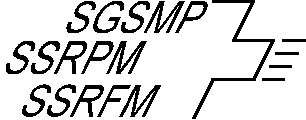
| andere Bulletins / d'autres bulletins / altri bolletini /
other bulletins ---------- Back to Main Page |
see also report for 1999 / see also summary of results 1991-99 Annual Intercomparison of Dose at a Reference Point in Water Using a Mailed TLD System Results for 1997 This year was a very busy one. There was an unusually heavy routine committment in the clinic, where 2 accelerators were fully re-commissioned following major hardware and software upgrades. Any spare time left was used for the breast phantom dosimetry intercomparison. You will gather therefore that time for the annual dosimetry intercomparison was short to non-existent. The delay in starting was also due to the fact that the TLD chips were being used for the breast phantom. There has been little change in therapy equipment in 1997 except for one accelerator and one Co source replacement. To reduce the workload, we decided to monitor the same beams as in 1996, but due to a shortage of TLD chips, the electron beams were left out of the intercomparison as were some Cobalt beams in institutes with accelerators. There are 22 radiation therapy centres in Switzerland. Of these, one did not wish to participate in the intercomparison. We "acquired" an institute in Holland. The procedure was the same as in the past years, i.e.,we used 2 dosemeters per beam and up to 3 beams per institute. The dosemeters were sent by mail with instructions describing the simple set-up and irradiation technique. From 21 mailings, 18 have responded (86%). Thus 36 beams from a planned 41 were available for assessment.
Table 1: Summary of beams by energy and respective % deviations. An overview of the results is shown in Table 1. All beams are within ±3% of the stated value. According to our convention, a deviation of <4% is considered acceptable, 4-7% a minor deviation and >7% a major deviation. In fact, irrespective of energy, 23 beams (64%) have a deviation of <1%, this is an excellent performance. Seven beams (19%) have a deviation of 1-2% and 6 beams (17%) have a deviation of 2-3%. This is our best result since we embarked on this programme seven years ago. However, this year electron beams were not included in the intercomparison. Figure 1 shows the deviations in the ratio dose measured/dose stated by each institute as measured by our institute. The mean deviation of all results is -0.18%, which is an indication that the dose calibration in Zurich is probably correct. Looking at each energy group individually, for 6MV photons, the mean deviation is -0.38%, for 18MV it is -0.25% and for Co-60 it is +0.73%. Figure 1: Scatter diagram of the results showing the deviations in the ratio of dose measured/stated for each institute. The missing data points represent the 4 institutes for which we have no data. Institute numbers have been re-randomised and are not the same as for previous years. From figure 2 it can be seen that the distribution of the deviations is approximately gaussian in shape and is centred in the -0.5% - +0.5% bin. The largest Co deviation is 3%, detected at the same institute that had a similar deviation last year. This cannot be explained at present. Unfortunately there are not enough Co beams to allow an analysis. It should be noted that of the 4 institutes for which we have no data this year, all have a Cobalt unit and for 3 of those, it is their only treatment unit. Figure 2: Data from figure 1 divided into bins of 1%. In summary it can be said that this year's results are very good indeed with 64% of the beams measured having a deviation within a ±1% bracket. We have measured no deviation >4%. These results would indicate a good homogeneity of dose calibration in this country. To conclude, we wish to thank our collaborators in Zurich. This year's intercomparison was done under difficult circumstances and is the effort of several members of the Medical Physics Team. We also thank all participants for their valuable co-operation, without which none of this would have been possible. B. Reiner / J.B.Davis (Zürich) |
||||||||||||||||||||||||||||||||||||
| top of page | This page
is maintained by Wolf W. Seelentag (Text by B.Reiner and
J.B.Davis). / Last updated 13 September 2011. Please forward any comments and/or additions to this webpage to the Webmaster SGSMP. |
||||||||||||||||||||||||||||||||||||